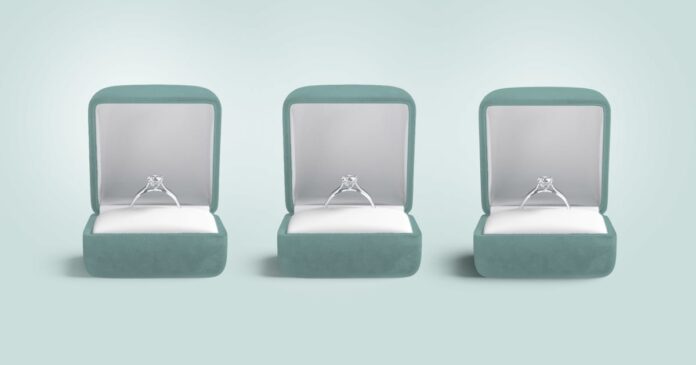Jewelry is often used to mark special occasions, acting as a symbol of love and commitment and sometimes becoming a cherished heirloom. Whether a retirement gift watch, a wedding ring or grandmother’s pearls, jewelry can be expensive to repair or replace, so it’s a good idea to think about how to protect the pieces that are significant to you.
While jewelry is usually covered by your home insurance or renters insurance policy, coverage limits are low. If you want to make sure your engagement and wedding rings are completely covered, or if you own an expensive necklace or an extensive watch collection, it often makes sense to buy a separate jewelry insurance policy.
Policies that cover individual pieces of jewelry or collections are sold both by large insurers you’ve probably heard of, and by smaller, specialty insurers that may be less familiar. Sometimes larger insurers sell policies on behalf of specialized insurers. (Geico, for instance, partners with Jewelers Mutual, instead of offering coverage directly.) You may also find companies that offer and service policies that are actually issued by larger insurance providers.
Regardless of how the insurance is sold, the best providers offer easy appraisals, flexible deductibles, high coverage limits and inexpensive premiums. The right insurer for you, however, will depend on your needs and budget.
To help you get started, here are our top picks for the best jewelry insurance companies.
Best overall
Why we picked it: Jewelers Mutual has been around for more than 100 years and has garnered support from the jewelry industry, including being the only insurer recommended by trade groups the American Gem Society and Jewelers of America.
In other words, Jewelers Mutual has a sterling reputation. It’s the largest company dedicated solely to insuring jewelry, and as a mutual company, it’s owned by its policyholders.
Jewelers Mutual doesn’t have a maximum or minimum dollar limit for your coverage, making it a good option for collections of all sizes. Deductible options range from $0 to $2,500 per claim. While some insurers don’t require a deductible, that typically means paying a higher premium. If you have savings to cover a higher deductible in the event of a claim, it could help reduce your monthly premiums.
The company’s premiums are in line with industry norms at 1% to 2% of the value of your items depending on where you live, with a minimum annual premium of $25 or $30. Additionally, Jewelers Mutual offers discounts to policyholders who have home security systems or store their jewelry in safe-deposit boxes at a bank. You can also save if you have your item inscribed with an identification number from an approved partner.
In most cases, you don’t need an appraisal to start coverage, though you will need one to file a claim. Most insurers require an upfront appraisal for higher-price pieces.
That said, it may be a good idea to eventually get an appraisal on file with the carrier. Your coverage limit with Jewelers Mutual is 100% of each piece’s value, and your protection will be based on documentation of value for your items, such as a receipt or an appraisal.
The company has a strong financial rating, earning an A-plus rating from AM Best, a credit agency that specializes in the insurance industry, which means that it’s well positioned to meet its policy obligations. It also has an extremely low company complaint index from the National Association of Insurance Commissioners, with just one complaint in 2022.
You can get a free quote through the insurer’s website in just 30 seconds without providing any personal information. Simply provide your ZIP Code, the type of jewelry you want to insure and its value.
Caveats: Jewelers Mutual customizes your coverage limit based on your item’s documented value, and it recommends getting an appraisal at least once every two years. But the insurer doesn’t account for appreciation in its limits—you’ll need to increase your coverage every time a new appraisal shows a higher value. If you don’t want to do regular appraisals, you can pay extra for an “Insurance Value Adjustment,” which increases your coverage limits automatically based on estimated value increases.
In contrast, some other insurance companies offer up to 150% of each insured item’s value from the start, giving you more time before you need to increase your coverage. Jewelers Mutual also doesn’t provide in-house appraisals.
Best for low premiums
Why we picked it: While the standard jewelry insurance cost is 1% to 2% of an insured item’s value annually, BriteCo’s range is lower at 0.5% to 1.5%. On a $6,000 engagement ring, for example, that could mean paying as little as $30 a year. (To get the best rates, you’ll need to store your jewelry in a safe or have a home security system and pay your premium annually instead of monthly.)
For the most part, the lower cost doesn’t mean sacrificing elsewhere. For example, despite its low premiums, the company doesn’t charge a deductible for most items.
BriteCo offers 125% of the replacement value of your piece, so you don’t necessarily need to buy more coverage if the value of your item increases. What’s more, the insurer automatically adjusts the replacement value for you, so you never need to get your item reappraised. The company has a maximum coverage of $150,000 per item and $500,000 for your entire collection, which is higher than most.
Note that BriteCo doesn’t issue its own policies. Instead, it partners with Glencar Insurance Company, which underwrites and issues the policies, while BriteCo administers them. Glencar Insurance Company has an A-plus rating from AM Best, and while its NAIC company complaint index is a bit higher than others in the industry, it only received two complaints in 2022.
If you’re buying an item from a jeweler that uses BriteCo’s appraisal system, you’ll automatically get a text with a jewelry insurance quote and can complete the application process while you’re at the store. If you didn’t buy from a BriteCo partner, you can request a quote online with just your name, email address, ZIP Code and item value.
Caveats: There are a few downsides to consider before picking BriteCo. For starters, the insurer requires an appraisal to get coverage, regardless of how valuable your jewelry piece is, but you’ll have 14 days after starting coverage to provide it. Most other options on our list don’t require an upfront appraisal on lower-price items.
Additionally, items that can’t be easily replaced, such as antiques and pieces from high-end brands (Harry Winston or Cartier, for example), have more limited coverage. Instead of its standard policy, you’ll get an “Agreed Value” policy, which pays out an agreed dollar amount in the event of a claim and typically includes a deductible.
Best for engagement rings
Why we picked it: With GemShield, you don’t need to get an appraisal to get coverage if your item is valued below $5,000—a detailed sales receipt will do. That makes it a solid choice for many newly engaged couples. According to The Knot, U.S. couples spend an average of $5,800 on an engagement ring, with about a third spending between $1,000 and $4,000.
In most cases, maximum coverage limits are $35,000 for individual items and $100,000 for your entire collection. That might not be enough for more valuable or extensive collections, but it might not matter if your primary objective is to protect an engagement ring. (However, if you expect to add to your collection over time, GemShield policies include automatic coverage for newly purchased jewelry for 30 days, giving you time to officially add it to your policy.)
Like most carriers, GemShield charges premiums between 1% and 2% of each item’s value annually. However, its minimum annual premium is the lowest on our list at $20, making coverage more affordable for lower-price pieces that aren’t fully covered by your homeowners or renters insurance policy. Deductibles range from $0 to $1,000, giving you more flexibility with your premium and out-of-pocket costs compared with other top options.
GemShield’s policy issuer, StarNet Insurance Company, has an A-plus financial strength rating from AM Best, and it also has a low NAIC company complaint index, with just one complaint in 2022.
You can get a quote with GemShield online with just your ZIP Code, the estimated value of your piece and your desired deductible.
Caveats: Unlike other insurers, GemShield doesn’t offer discounts for safe storage and doesn’t do in-house appraisals. And it doesn’t offer more than 100% of the replacement value for each item, which means that you may need to get appraisals more often and buy more coverage if your jewelry increases in value.
Additionally, because GemShield’s dollar coverage limits are relatively low compared with other insurance carriers, it might not be a good fit for higher-price items and collections.
Best for flexible deductibles
Why we picked it: A low—or even no—deductible can be helpful for consumers who don’t have savings to cover claim-related costs. However, if you can afford to pay a higher deductible, you can usually qualify for a lower premium as a result.
With Lavalier, you’ll get ultimate flexibility with your deductible, which can range from $0 to $25,000, making it easier to balance your budget for premiums with your ability to self-insure in the event of loss or damage. Your specific deductible options will depend on the value of each item you want to insure.
There is a maximum coverage limit of $50,000 per piece and $150,000 for a schedule of items, though the insurer may make exceptions based on a special review. The company offers discounts to policyholders with a home security system, a home safe, a gemstone grading report, or storage in a bank vault or safe-deposit box.
If the item you want to insure is worth $5,000 or more, you’ll need to provide an appraisal to obtain coverage. If the item’s value is below that threshold, you can share a detailed sales receipt instead.
Lavalier partners with Berkley National Insurance Company to issue the policies it administers. Berkley National Insurance Company has an A-plus financial strength rating from AM Best and a low NAIC company complaint index, with just one complaint in 2022.
You can get a quote with just your ZIP Code, the value of your item and a deductible preference.
Caveats: Lavalier’s minimum annual premium is high compared with other options on our list. Regardless of the value of the items you want to cover, the minimum premium is $50 a year, making it less appealing for jewelry worth around $2,500 or less.
Additionally, Lavalier only offers coverage up to 100% of a piece’s replacement value, so you may want to obtain appraisals regularly to ensure you always have enough protection. Lavalier doesn’t offer appraisals as part of its service.
Finally, Lavalier doesn’t offer coverage for watches on a stand-alone basis—you can, however, get protection for these items if you add other jewelry items to your policy.
Best for high coverage limits
Why we picked it: If you have a sizable collection of jewelry, Chubb might be the best fit. There is no set dollar limit and the insurer will pay up to 150% of your item’s value to account for appreciation. You’ll also get automatic coverage for new jewelry items for up to 90 days to give you time to add them to your schedule of items.
The company doesn’t require an appraisal unless your item is valued at $100,000 or more. If it’s less than that, Chubb just needs a description and an estimated value. Again, it’s still a good idea to get an appraisal to ensure proper coverage, but once you have one, you won’t need to get them as regularly as you might with other insurers thanks to the high payback amount.
In addition to insurance protection, Chubb provides a collection valuation review, which can help you determine whether you need a new appraisal, and a risk assessment of your storage and safekeeping practices. It doesn’t offer appraisal services, however.
Like other insurers, Chubb premiums range from 1% to 2% of the value of your items, and the insurance provider doesn’t require a deductible. It also offers a discount for bank-vault storage.
Chubb has an A-plus-plus financial strength rating from AM Best—the highest the credit rating company offers—and a below-average company complaint index based on its size. The company received a total of 10 complaints in 2022, but that encompasses all of its insurance offerings, which also include home, auto and travel insurance, among others.
Caveats: With a minimum coverage requirement of $15,000 (for a single item or several pieces), Chubb isn’t going to be a fit for people with less valuable items or collections.
Chubb’s quote process is cumbersome compared with those of other insurers on our list. The company gathers some basic information about what you want covered, then provides contact information for insurance agencies in your area that offer Chubb coverage. Unfortunately, it isn’t possible to get a quote online; you’ll need to contact the agency of your choice by phone, by email or in person.
The extra legwork to get a quote may make the insurer less attractive if you can get the coverage you need from another provider. But if you need the extra coverage Chubb offers, it might be worth it.
Other insurers we considered
In our search for the best jewelry insurance providers, we considered several other options that ultimately didn’t make our list, including:
- Zillion: Zillion didn’t make our list because it doesn’t sell coverage directly to consumers. However, if you are purchasing jewelry through a partner, Zillion offers a quick and easy process. Zillion offers a free appraisal and even provides coverage while you’re still deciding on the quote.
- WAX: WAX Insurance offers policies underwritten by Chubb, so you can get the same high coverage limits without the burdensome quote process. You can get a quote online by providing your name, email address and ZIP Code, along with your jewelry collection value.
How does jewelry insurance work?
Jewelry insurance offers financial protection in the event that a covered item is damaged, lost or stolen.
When you apply for coverage, you may or may not need to have the item appraised. If the insurer offers an appraisal service, you can work directly with them to get a value for your piece. Otherwise, you can find a credentialed appraiser through trade associations like the National Association of Jewelry Appraisers or the American Gem Society.
You can expect to pay between $50 and $150 an hour for an appraisal depending on the complexity of the item. For example, a simple wedding band will cost less to appraise than a multistone engagement ring. Be sure to check with your insurer to understand the requirements for an acceptable appraisal before you pay for one.
In many cases, stand-alone jewelry insurance policies cover pieces on an “all risks” basis, which means that you’re covered for any peril unless it’s specifically excluded from the policy.
Jewelry insurance policies typically offer replacement value, or the dollar amount currently needed to replace the item. That is instead of actual cash value, which subtracts depreciation and is common with home and auto insurance. If you need to file a claim, you’ll pay the applicable deductible, and it will typically take two or three weeks to get the repaired or replacement item or reimbursement.
Is jewelry insurance worth it?
If you have a homeowners or renters insurance policy, you may already have a small amount of coverage included in your policy. But depending on the insurer, the standard coverage is typically only $1,500. If you want more coverage, you may consider an add-on to your homeowners or renters policy or a stand-alone jewelry insurance policy.
You may also decide to buy a jewelry insurance policy if your homeowners insurance policy has other limits on coverage. For example, if it doesn’t offer replacement value or you’re protected against damage and theft but not accidental loss, a stand-alone policy may give you more peace of mind.
But remember, a jewelry insurance policy is an added cost. If you want to insure a $10,000 ring, you can expect to pay an annual premium of $100 to $200, depending on the insurer, your location and your deductible amount. If you can get add-on coverage through your homeowners or renters insurance for less than that, and the coverage details work for your needs, a separate policy may not be necessary.
Jewelry Insurance FAQs
Do you have to pay a deductible with jewelry insurance?
With a standalone jewelry insurance policy, you typically have a deductible — the amount of money you have to pay before your insurance will pay for your damaged or stolen jewelry. Deductible options vary by insurer, but you can usually choose a deductible between $0 and $1,000.
Does jewelry insurance cover pieces you lost?
With homeowners or renters insurance policies, you may not be covered for lost jewelry; many policies will only cover pieces that are stolen or damaged in a qualifying accident, such as a fire.
However, separate jewelry insurance policies provide coverage for jewelry that you lose. Whether you left the ring on the bathroom counter at work or it fell out of your suitcase at the airport, your policy will cover the loss.
What happens if you find a ring after filing an insurance claim?
If you filed a claim for a piece of jewelry and later found it, most policies require you to notify the insurer right away. In most cases, you’ll either have to return the money you received for the claim or return the new piece of jewelry you bought to replace the lost item; the insurer will sell the piece to recoup some of their loss.
What doesn’t jewelry insurance cover?
Jewelry insurance policies typically exclude losses or damages related to the following issues:
- Voluntary parting: If you sell a piece of jewelry to a local buyer and their check bounces, the loss isn’t covered.
- Deterioration or inherent vice: Usually applying to delicate or antique pieces that are already fragile, damages resulting from existing weaknesses or faults aren’t covered.
- Intentional acts: If you intentionally lose or damage a piece of jewelry, your claim will be denied.
- Vermin or insects: If you store your jewelry in an attic or basement and rodents or insects eat away at the chain, your insurer will deny the claim.
- Civil authority: Jewelry confiscated during a search by law enforcement is not covered.
- Maintenance: Routine cleaning, inspection and resizing costs aren’t covered.
How does jewelry insurance compare to jeweler warranties or service plans?
Some jewelers sell service plans or warranties, but they function very differently from insurance policies. Service plans and warranties are for a limited time — such as one to five years after the purchase date — and they will pay for the repair or replacement of pieces that show signs of damage or deterioration from normal use. For example, it would pay to fix a ring with a loose prong. Service plans and warranties don’t provide coverage for accidental damages — such as a cracked stone — or lost or stolen jewelry.
What is the maximum coverage limit for jewelry insurance?
Coverage limits vary by insurer, but most companies have limits per single piece of jewelry and per schedule of items, meaning the total list of the pieces you insure. The maximum amount of coverage you can get is typically around $50,000 per single piece of jewelry, and $150,000 per schedule of items. However, there are some insurers, such as Brite, that provide higher coverage limits.
What information do I need to provide to insure a piece of jewelry?
To insure a piece of jewelry, you’ll need the following information:
- Appraisal: A jewelry appraisal report must be completed by a qualified jewelry professional or appraiser. The appraisal includes a detailed description of the piece, estimates of its value or the cost to recreate it. Appraisals are particularly important for older pieces that you may not have sales receipts for or inherited pieces.
- Sales receipt: If you recently bought the jewelry you wish to insure, provide a copy of the sales receipt to show the value of the piece at the time of purchase.
- Lab report: With some pieces, a lab report may be necessary. Lab reports are identification tests based on the chemical and physical properties of the gemstones and metals. The result will include the metal properties, descriptions of each gem (including cut and carat weight), color, and clarity grades.
- Photographs: You’ll need to submit multiple pictures of the covered piece.
How we picked
We chose Buy Side from WSJ’s Best Jewelry Insurance Companies based on cost, appraisal requirements, coverage limits, quote processes, financial strength ratings and NAIC complaint indexes.
In terms of cost, we looked at minimum premiums and deductible flexibility. We also considered whether a carrier required an appraisal to obtain coverage based on the value of the items you might want to insure. Coverage limits were also an important factor, both in terms of individual pieces and full collections.
Financial strength ratings are a critical factor in determining an insurance provider’s ability to meet its policy obligations, so we only included companies with top marks, and we focused on insurers with low complaint totals compared with the rest of the industry.
Some large insurers, such as State Farm, offer coverage for jewelry through a personal articles policy. However, we did not consider insurers that offer coverage through personal articles insurance because they cover a wider range of personal belongings.
(Kat Tretina contributed to this article.)
The advice, recommendations or rankings expressed in this article are those of the Buy Side from WSJ editorial team, and have not been reviewed or endorsed by our commercial partners.




![[Toyota Times] From Strengthening Foundations to Boosting Productivity – Toyota Focuses on Break-Even Volume [Toyota Times] From Strengthening Foundations to Boosting Productivity - Toyota Focuses on Break-Even Volume](https://businessfortnight.com/wp-content/uploads/2025/11/Toyota-Times-From-Strengthening-Foundations-to-Boosting-Productivity-Toyota-218x150.jpg)





























